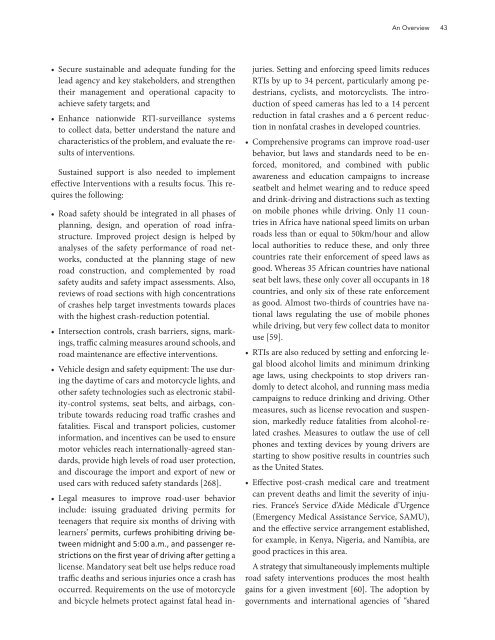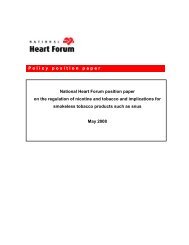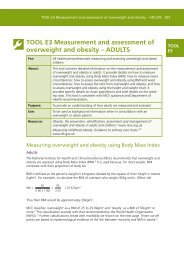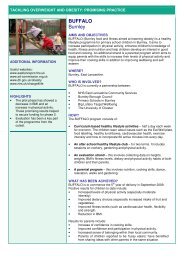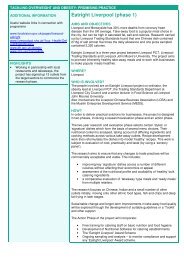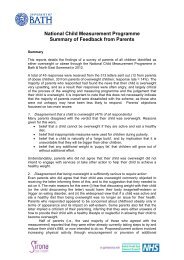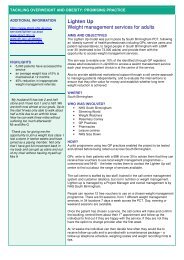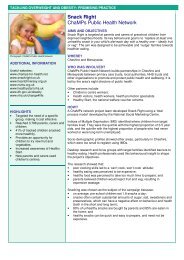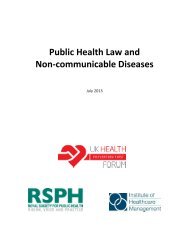The Challenge of Non-Communicable Diseases and Road Traffic ...
The Challenge of Non-Communicable Diseases and Road Traffic ...
The Challenge of Non-Communicable Diseases and Road Traffic ...
Create successful ePaper yourself
Turn your PDF publications into a flip-book with our unique Google optimized e-Paper software.
An Overview 43<br />
• Secure sustainable <strong>and</strong> adequate funding for the<br />
lead agency <strong>and</strong> key stakeholders, <strong>and</strong> strengthen<br />
their management <strong>and</strong> operational capacity to<br />
achieve safety targets; <strong>and</strong><br />
• Enhance nationwide RTI-surveillance systems<br />
to collect data, better underst<strong>and</strong> the nature <strong>and</strong><br />
characteristics <strong>of</strong> the problem, <strong>and</strong> evaluate the results<br />
<strong>of</strong> interventions.<br />
Sustained support is also needed to implement<br />
effective Interventions with a results focus. This requires<br />
the following:<br />
• <strong>Road</strong> safety should be integrated in all phases <strong>of</strong><br />
planning, design, <strong>and</strong> operation <strong>of</strong> road infrastructure.<br />
Improved project design is helped by<br />
analyses <strong>of</strong> the safety performance <strong>of</strong> road networks,<br />
conducted at the planning stage <strong>of</strong> new<br />
road construction, <strong>and</strong> complemented by road<br />
safety audits <strong>and</strong> safety impact assessments. Also,<br />
reviews <strong>of</strong> road sections with high concentrations<br />
<strong>of</strong> crashes help target investments towards places<br />
with the highest crash-reduction potential.<br />
• Intersection controls, crash barriers, signs, markings,<br />
traffic calming measures around schools, <strong>and</strong><br />
road maintenance are effective interventions.<br />
• Vehicle design <strong>and</strong> safety equipment: <strong>The</strong> use during<br />
the daytime <strong>of</strong> cars <strong>and</strong> motorcycle lights, <strong>and</strong><br />
other safety technologies such as electronic stability-control<br />
systems, seat belts, <strong>and</strong> airbags, contribute<br />
towards reducing road traffic crashes <strong>and</strong><br />
fatalities. Fiscal <strong>and</strong> transport policies, customer<br />
information, <strong>and</strong> incentives can be used to ensure<br />
motor vehicles reach internationally-agreed st<strong>and</strong>ards,<br />
provide high levels <strong>of</strong> road user protection,<br />
<strong>and</strong> discourage the import <strong>and</strong> export <strong>of</strong> new or<br />
used cars with reduced safety st<strong>and</strong>ards [268].<br />
• Legal measures to improve road-user behavior<br />
include: issuing graduated driving permits for<br />
teenagers that require six months <strong>of</strong> driving with<br />
learners’ permits, curfews prohibiting driving between<br />
midnight <strong>and</strong> 5:00 a.m., <strong>and</strong> passenger restrictions<br />
on the first year <strong>of</strong> driving after getting a<br />
license. M<strong>and</strong>atory seat belt use helps reduce road<br />
traffic deaths <strong>and</strong> serious injuries once a crash has<br />
occurred. Requirements on the use <strong>of</strong> motorcycle<br />
<strong>and</strong> bicycle helmets protect against fatal head injuries.<br />
Setting <strong>and</strong> enforcing speed limits reduces<br />
RTIs by up to 34 percent, particularly among pedestrians,<br />
cyclists, <strong>and</strong> motorcyclists. <strong>The</strong> introduction<br />
<strong>of</strong> speed cameras has led to a 14 percent<br />
reduction in fatal crashes <strong>and</strong> a 6 percent reduction<br />
in nonfatal crashes in developed countries.<br />
• Comprehensive programs can improve road-user<br />
behavior, but laws <strong>and</strong> st<strong>and</strong>ards need to be enforced,<br />
monitored, <strong>and</strong> combined with public<br />
awareness <strong>and</strong> education campaigns to increase<br />
seatbelt <strong>and</strong> helmet wearing <strong>and</strong> to reduce speed<br />
<strong>and</strong> drink-driving <strong>and</strong> distractions such as texting<br />
on mobile phones while driving. Only 11 countries<br />
in Africa have national speed limits on urban<br />
roads less than or equal to 50km/hour <strong>and</strong> allow<br />
local authorities to reduce these, <strong>and</strong> only three<br />
countries rate their enforcement <strong>of</strong> speed laws as<br />
good. Whereas 35 African countries have national<br />
seat belt laws, these only cover all occupants in 18<br />
countries, <strong>and</strong> only six <strong>of</strong> these rate enforcement<br />
as good. Almost two-thirds <strong>of</strong> countries have national<br />
laws regulating the use <strong>of</strong> mobile phones<br />
while driving, but very few collect data to monitor<br />
use [59].<br />
• RTIs are also reduced by setting <strong>and</strong> enforcing legal<br />
blood alcohol limits <strong>and</strong> minimum drinking<br />
age laws, using checkpoints to stop drivers r<strong>and</strong>omly<br />
to detect alcohol, <strong>and</strong> running mass media<br />
campaigns to reduce drinking <strong>and</strong> driving. Other<br />
measures, such as license revocation <strong>and</strong> suspension,<br />
markedly reduce fatalities from alcohol-related<br />
crashes. Measures to outlaw the use <strong>of</strong> cell<br />
phones <strong>and</strong> texting devices by young drivers are<br />
starting to show positive results in countries such<br />
as the United States.<br />
• Effective post-crash medical care <strong>and</strong> treatment<br />
can prevent deaths <strong>and</strong> limit the severity <strong>of</strong> injuries.<br />
France’s Service d’Aide Médicale d’Urgence<br />
(Emergency Medical Assistance Service, SAMU),<br />
<strong>and</strong> the effective service arrangement established,<br />
for example, in Kenya, Nigeria, <strong>and</strong> Namibia, are<br />
good practices in this area.<br />
A strategy that simultaneously implements multiple<br />
road safety interventions produces the most health<br />
gains for a given investment [60]. <strong>The</strong> adoption by<br />
governments <strong>and</strong> international agencies <strong>of</strong> “shared


